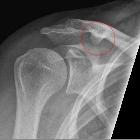rhomboid fossa of the clavicle
Rhomboid fossa of the clavicle is recognised as a concave impression of the inferior surface of the sternal (medial) end of the clavicle . It is a normal anatomical variant that can be seen unilaterally (more often) or bilaterally.
Epidemiology
It is more common in males than females, and young adults . The largest fossae are reported as more common in males 20-30 years of age .
Unilateral presence of the rhomboid fossa is correlated with the handedness, being present more frequently on the right side in right-handed patients and on the left side in left-handed patients . Hence, it is seen more often on the right than the left side .
Pathology
The sternal end of the clavicle is bound with the first costal cartilage and the adjacent end of the first rib via the costoclavicular ligament. The concluded correlation between rhomboid fossa and handedness enhances the mechanical theory of fossa formation due to applied pressure by costoclavicular ligament .
Radiographic features
Plain radiograph
It appears on plain frontal radiograph as a roughened area along the inferior surface of the medial end of the clavicle and serves as an attachment for the costoclavicular ligament.
Siehe auch:
und weiter:

 Assoziationen und Differentialdiagnosen zu rhomboid fossa of the clavicle:
Assoziationen und Differentialdiagnosen zu rhomboid fossa of the clavicle:

